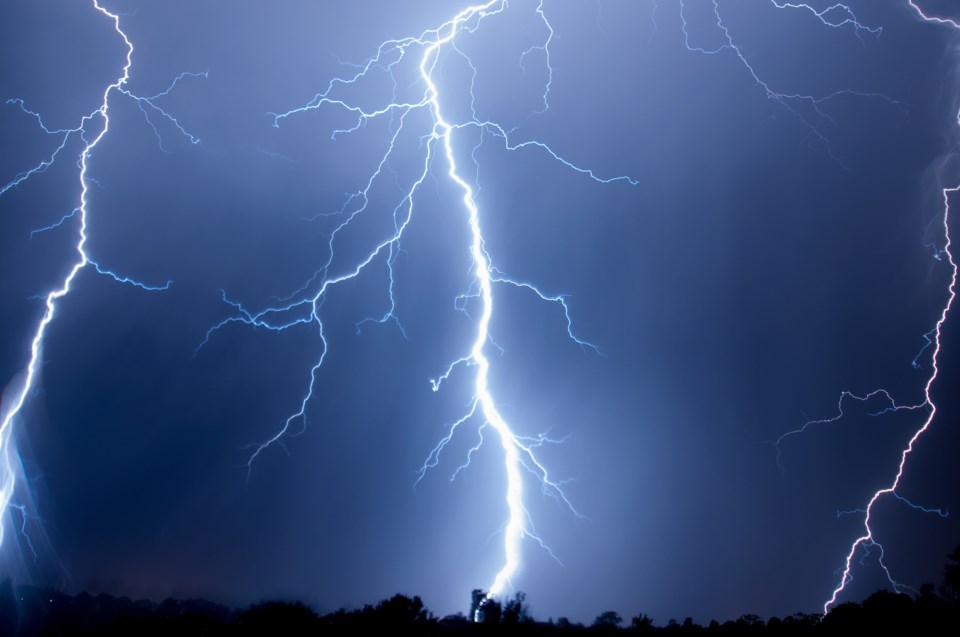BANFF – Three people were struck by lightning or electric ground currents in Banff National Park during a severe thunderstorm last weekend.
A 28-year-old woman from Calgary who was scrambling on Mount Bourgeau west of the Banff townsite ended up in Banff Mineral Springs Hospital after lightning hit Saturday afternoon (July 27).
“She wasn’t physically injured severely, but she suffered from short-term memory loss and some of her clothing was melted from the strike,” said Brian Webster, manager of visitor services for Banff National Park.
“Any time you get struck by lightning or get struck by ground currents that are that strong, you are quite lucky indeed. It was an extremely close call and it could have turned out a lot worse. We’re just glad it turned out as good as it did.”
The woman didn’t even realize she had been struck by lightning, according to her rescuers.
“She just knew that she was disoriented and had some memory loss and she called 911 using her cellphone,” said Webster, noting 911 in turn contacted Banff’s rescue team at 1:10 p.m..
At this point, Banff’s visitor safety specialists weren’t sure what happened to the woman, but knew she was in distress. Rescuers were flown by helicopter to Mount Bourgeau and landed close to the woman’s location.
“They discerned she had some form of a lightning strike, just by speaking with her and seeing she had some melted clothing,” Webster said.
Details are scant on the other two people struck by lightning or ground currents from the strike that day. Two Idaho men, in their early 20s, were on the scramblers route on Mount Temple when they called 911 to report the incident.
“I suspect they had some sort of ground current. It wasn’t a direct strike, but they received some sort of electrical discharge,” Webster said.
“They basically called to give a heads up because they were concerned for other hikers on the mountain.”
A lightning bolt is a million times more powerful than a household current, carrying up to 100 million volts of electricity. When someone is struck by lightning, an electrical shock occurs that can cause burns and even stop a person’s breathing.
According to Environment Canada, there are more than two million lightning strikes on average each year across the country. Despite the relatively short lightning season, nine to 10 people are killed and between 100 and 150 people are injured each year.
“There’s direct strikes to the individual, there’s ground current, there’s flashovers from nearby objects,” said meteorologist Dan Kulak.
Kulak said the woman who was struck on Mount Bourgeau is “beyond lucky.”
“The higher up in the mountain and on those peaks is a dangerous area when thunderstorms are developing,” he said.
“The Banff area is not the most lightning prone area in the province, but generally anywhere in the province is essentially vulnerable to the threat of lightning.”
Kulak said there was a cluster of lightning strikes in the area immediately west of Banff between 12:30-1 p.m. He estimates the strike hit Mount Bourgeau between 12:30-12:41 p.m..
“We detected eight general strikes,” he said.
In Alberta, there are 400,000 lighting strikes on average each year. Last year, there were approximately 376,000 lightning strikes and so far this year the number of strikes is up to 399,000 with another month of the lightning season to go.
“Back in 2016, we had 585,000 strikes so it’s variable from year to year,” said Kulak, adding the lightning season in Alberta starts in May and tapers off towards the latter part of August and into September.
The statistics show the odds of being struck by lighting are low, but Parks Canada public safety officials are shocked it doesn’t happen more often in Banff, which attracts close to four million visitors a year.
“Given the number of people that are out there up high on any given day and in any given weather, it’s a bit surprising that there isn’t more instances or close calls like this,” Webster said. “I feel like we’re fortunate there aren’t more.”
Parks Canada has some safety messages following the lightning strikes in Banff National Park
When there’s any hint that a thunderstorm is going to be rolling through, people should get below treeline as quickly as possible so they are not exposed.
Webster said if people get surprised and caught in a thunderstorm, there are a few strategies that will help.
“If you’re on summits or high points, that’s going to be the worst area to be, so you want to get off those high points, get off those ridges and get onto the slopes below those ridges,” he said.
“Even if you are experiencing electrical activity, just continuing to move downhill is a good idea rather than just hunkering down.”
If caught in a lightning storm, immediately get rid of any metal objects like an ice axe or hiking poles.
“You can always go back, but just get rid of anything that’s metal and go off to separate place where you’re hunkering down,” Webster said.
A good hint that there’s a lightning storm approaching is people can start to feel their hair stand on end, and in some cases, can hear a bit of a buzzing sound.
“Those would be good clues that there is electricity in the air and that there’s very likely a storm approaching,” Webster said.




